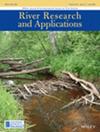Spring forth diversity: Specialist species contribute to the conservation value of headwater springs and streams at the landscape scale
IF 1.9
4区 环境科学与生态学
Q4 ENVIRONMENTAL SCIENCES
引用次数: 0
Abstract
Headwater springs and streams often occur in relatively remote areas, reducing their exposure to human influences and thus increasing their collective capacity to support high biodiversity. Their aquatic macroinvertebrate communities can include species of conservation interest, some of which are specialists associated with groundwater inputs, low water temperature or temporary flow. However, the inaccessibility of some spring and stream networks has left their communities poorly characterized, limiting our capacity to implement effective conservation strategies. We characterized the biodiversity and conservation value of macroinvertebrate communities in a network of 51 relatively inaccessible and unimpacted headwater spring and stream sites spanning multiple catchments in a single landscape type: the chalk downland of south England. At each site, we kick sampled macroinvertebrate communities and recorded environmental variables, including flow permanence. To represent each community, we calculated taxa richness, coverage-adjusted Hill-Shannon diversity, the local contribution to beta diversity, and an index of richness and species rarity. We used the latter three metrics to rank sites based on their biodiversity and conservation value and analyzed relationships between metrics and environmental variables. We found specialists of springs, cold waters, groundwaters and temporary flow regimes, including rare species of conservation value. Some metrics responded to environmental variables, but top-ranking sites had highly variable environmental characteristics. We highlight the value of individual headwater streams with contrasting characteristics as contributors to ecologically heterogeneous site networks. Our results can inform landscape-scale management strategies that protect headwaters as refuges that support biodiverse communities, including rare species, as they adapt to global change.泉水多样性:特殊物种在景观尺度上有助于保护源头泉水和溪流的价值
源头水泉和溪流通常位于相对偏远的地区,这减少了它们受人类影响的机会,从而提高了它们支持高度生物多样性的集体能力。它们的水生大型无脊椎动物群落可能包括具有保护价值的物种,其中一些是与地下水输入、低水温或临时水流有关的专家。然而,由于一些泉水和溪流网络无法进入,它们的群落特征并不明显,这限制了我们实施有效保护策略的能力。我们在英格兰南部白垩低地这一单一地貌类型的多个集水区中,对 51 个相对难以接近且未受影响的泉水和溪流网络中的大型无脊椎动物群落的生物多样性和保护价值进行了描述。在每个地点,我们都对大型无脊椎动物群落进行了采样,并记录了环境变量,包括水流的持久性。为了代表每个群落,我们计算了类群丰富度、覆盖率调整后的希尔-香农多样性、当地对贝塔多样性的贡献以及丰富度和物种稀有度指数。我们利用后三个指标对地点的生物多样性和保护价值进行排序,并分析指标与环境变量之间的关系。我们发现了泉水、冷水、地下水和临时水流机制的专家,包括具有保护价值的稀有物种。一些指标对环境变量做出了反应,但排名靠前的地点的环境特征变化很大。我们强调了具有截然不同特征的单个上游溪流作为生态异质性地点网络贡献者的价值。我们的研究结果可以为景观尺度的管理策略提供信息,从而保护溪流,使其成为支持生物多样性群落(包括珍稀物种)的庇护所,以适应全球变化。
本文章由计算机程序翻译,如有差异,请以英文原文为准。
求助全文
约1分钟内获得全文
求助全文
来源期刊

River Research and Applications
环境科学-环境科学
CiteScore
4.60
自引率
9.10%
发文量
158
审稿时长
6 months
期刊介绍:
River Research and Applications , previously published as Regulated Rivers: Research and Management (1987-2001), is an international journal dedicated to the promotion of basic and applied scientific research on rivers. The journal publishes original scientific and technical papers on biological, ecological, geomorphological, hydrological, engineering and geographical aspects related to rivers in both the developed and developing world. Papers showing how basic studies and new science can be of use in applied problems associated with river management, regulation and restoration are encouraged as is interdisciplinary research concerned directly or indirectly with river management problems.
 求助内容:
求助内容: 应助结果提醒方式:
应助结果提醒方式:


